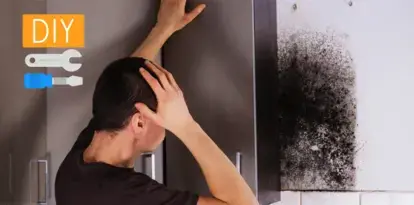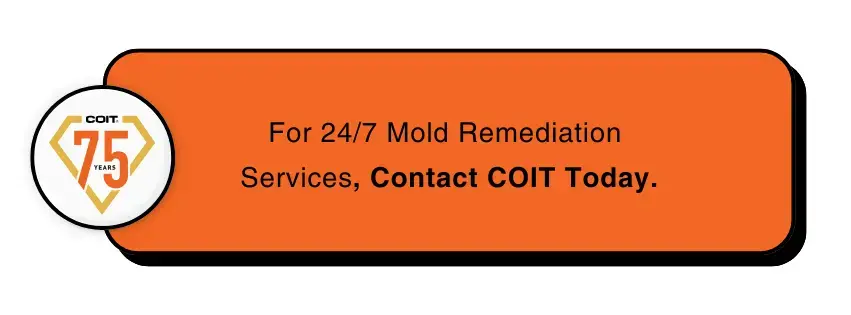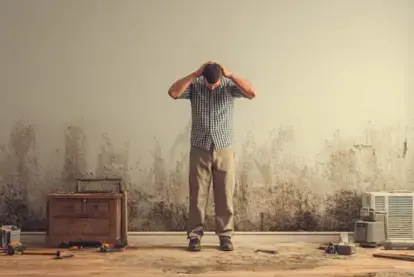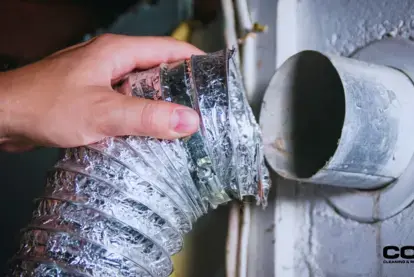
How to Do Mold Remediation Yourself: A Step-by-Step Guide
Contact COIT for a professional cleaning!
Whether it’s from heavy rain, snow, or just high humidity, moisture can find its way into your home, leading to one unwelcome guest: mold.
If you’ve discovered mold in your house, you’re likely wondering if you can handle the cleanup yourself. The short answer is yes, but it’s important to know what you’re getting into and how to do it safely.
In this guide, we’ll walk you through everything you need to know about doing mold remediation yourself.
As cleaning experts, we want to equip you with the right knowledge to tackle the problem effectively. We also want to make sure you’re aware of when it’s time to call in the professionals!
Understanding Mold: Types and Where It Grows
Before you start cleaning, it’s essential to understand what you’re dealing with. Mold comes in different types, each requiring slightly different approaches for removal.
Here’s a quick overview of the most common molds you might find in your home:
Cladosporium
Often found on wood, carpet, and fabrics. This mold can appear in either black or green and typically grows in damp areas like basements or bathrooms.
Penicillium
Known for its blue or green appearance, this mold thrives on materials like insulation, wallpaper, and carpets that have been exposed to moisture.
Aspergillus
This mold can look white, yellow, or green and is often found on damp walls, wallpaper, and fabric. It can cause respiratory issues, so it’s crucial to handle it carefully.
Stachybotrys chartarum (Black Mold)
This is the infamous “black mold” that can produce toxic spores. It thrives in very wet conditions, often growing on materials like wood, paper, and drywall that have been water-damaged. This type of mold is particularly dangerous and may require professional intervention.
Mold can grow almost anywhere in your home where moisture is present. Common spots include:
- Bathrooms: Especially in tile grout, around sinks, and in shower stalls.
- Basements: On walls, floors, and ceilings, particularly if the area is prone to dampness.
- Kitchens: Under sinks, around windows, and behind appliances.
- Attics: On roof beams, insulation, and stored items.
- Windowsills: Especially in older homes with wooden frames.

Should You DIY Mold Remediation or Hire a Professional?
Now that you know where mold might be hiding, the next question is whether you should try to clean it up yourself. We’re here to guide you, but it’s important to recognize the limitations of DIY mold remediation.
When to DIY:
- Small Areas (Less than 10 square feet): If the moldy area is small and confined to surfaces like tile, painted walls, or wooden furniture, you can likely handle it yourself with the right precautions.
- Surface Mold: Mold growing on non-porous surfaces like tile, glass, or metal can be cleaned relatively easily.
- Visible and Accessible: If you can see the mold and it’s easy to access, DIY might be a good option.
When to Call a Professional:
- Large Areas (More than 10 square feet): Large infestations can be dangerous and require specialized equipment and expertise.
- HVAC Systems: Mold in your heating, ventilation, and air conditioning system can spread spores throughout your home and should only be handled by a professional.
- Water Damage: If the mold is a result of significant water damage, especially if it involves contaminated water (like sewage), call a pro.
- Black Mold: As we mentioned earlier, Stachybotrys chartarum (black mold) can be hazardous and often requires professional remediation.
- Health Concerns: If anyone in your home has respiratory issues, allergies, or a weakened immune system, it’s safer to let the experts handle the cleanup.
Our Professional Recommendation:
We believe that safety should always come first. While it’s possible to tackle small, non-toxic mold problems on your own, professional mold remediation ensures that the job is done thoroughly and safely. We use specialized tools and techniques to remove mold completely and prevent it from returning.
Learn more about COIT’s Mold Remediation and schedule or request a service today.
Preparing for Mold Remediation: Safety First
If you’ve decided to move forward with DIY mold remediation, the first and most important step is to protect yourself. Mold spores can be hazardous to your health, so take the following precautions:
Personal Protective Equipment (PPE)
- Goggles: Wear safety goggles that seal against your face to prevent mold spores from getting into your eyes.
- Gloves: Use long rubber gloves that cover your wrists to avoid contact with mold and cleaning chemicals.
- HEPA Respirator Mask: A high-quality HEPA mask will filter out harmful mold spores, protecting your lungs.
- Disposable Clothing or Coveralls: Wear old clothes that you can wash immediately after cleaning, or better yet, disposable coveralls that you can discard.
Containment
- Seal the Area: Close off the affected area from the rest of the house. Use plastic sheeting and tape to seal off doors, vents, and windows.
- Negative Pressure: If possible, create negative pressure in the room by using a fan to blow air out a window. This helps prevent spores from spreading to other parts of your home.
- Remove and Bag Contaminated Items: Any items that have come into contact with mold (like rags, sponges, and clothing) should be sealed in plastic bags before disposing of them.
Tools and Materials You’ll Need
- Spray Bottles: For applying cleaning solutions.
- Scrub Brushes: Use different sizes for various surfaces.
- Rags or Sponges: For wiping down surfaces.
- Buckets: For mixing cleaning solutions.
- Plastic Sheeting: To contain the area.
- Fans: To help dry the area after cleaning.

DIY Mold Remediation: Step-by-Step Process
Now, let’s get into the nitty-gritty of how to do mold remediation yourself. Follow these steps carefully to ensure a thorough and safe cleanup.
Step 1: Identify the Source of Moisture
Mold is a symptom of a moisture problem. If you don’t address the underlying issue, the mold will return. Look for leaks, condensation, or other sources of moisture in the affected area and fix them before you start cleaning.
Step 2: Prepare the Area
As mentioned earlier, seal off the affected area to prevent mold spores from spreading. Remove any furniture, rugs, or other items that could be contaminated, and dispose of them if necessary.
Step 3: Apply the Cleaning Solution
There are several effective mold-killing solutions you can use. Here are some options:
Vinegar
White distilled vinegar is mildly acidic and can kill 82% of mold species. It’s a great option for most DIYers.
How to Use: Pour undiluted vinegar into a spray bottle. Spray the affected area and let it sit for at least an hour. Then, scrub with a brush and wipe clean with a damp cloth.
Hydrogen Peroxide:
A 3% hydrogen peroxide solution can kill mold and is also a disinfectant.
How to Use: Pour the hydrogen peroxide into a spray bottle. Spray the moldy area, let it sit for 10 minutes, then scrub and wipe clean.
Baking Soda:
Baking soda not only kills mold but also deodorizes and prevents future mold growth.
How to Use: Mix one-quarter of a tablespoon of baking soda with water in a spray bottle. Spray the solution on the mold, scrub it off, then rinse with water and reapply the solution to prevent future growth.
Tea Tree Oil:
This natural fungicide is effective but more expensive.
How to Use: Mix one teaspoon of tea tree oil with one cup of water in a spray bottle. Apply to the moldy area, let it sit, then scrub and wipe clean.
Step 4: Scrub and Clean
After letting your chosen solution sit on the mold for the recommended time, it’s time to scrub. Use a stiff-bristled brush to scrub the mold off the surface.
For tough spots, you might need to reapply the cleaning solution.
Step 5: Rinse and Dry
Once the mold is scrubbed away, rinse the area with clean water to remove any remaining cleaning solution. Use a clean rag or sponge to wipe down the surface.
Then, use fans or a dehumidifier to dry the area thoroughly. Mold thrives in moisture, so making sure the area is completely dry is crucial.
Step 6: Dispose of Contaminated Materials
Seal any contaminated materials (like scrub brushes, rags, and disposable clothing) in plastic bags before disposing of them. This will help prevent mold spores from spreading to other areas of your home.
Step 7: Prevent Future Mold Growth
Prevention is key to keeping mold from returning. Here are some tips to keep your home mold-free:
- Control Humidity: Keep indoor humidity levels below 50%. Use a dehumidifier in damp areas like basements and bathrooms.
- Ventilate: Ensure your home is well-ventilated, especially in areas prone to moisture. Use exhaust fans in bathrooms and kitchens, and open windows when possible.
- Fix Leaks Immediately: Repair any leaks in roofs, windows, or pipes as soon as they occur.
- Clean Regularly: Regular cleaning and maintenance, especially in moisture-prone areas, will help prevent mold growth.
When DIY Isn’t Enough: Calling in the Experts
Even with the best efforts, some mold problems are just too big or dangerous to handle on your own. If you’ve gone through these steps and still have concerns, or if you’re dealing with a large infestation or toxic mold, it’s time to call in the professionals.
At COIT, we specialize in professional mold remediation. We use advanced techniques and equipment to completely remove mold and prevent it from coming back. Our team is trained to handle even the most severe cases, ensuring that your home is safe and mold-free.
Learn more about COIT’s Mold Remediation and schedule or request a service today.
Final Thoughts
Mold is a serious issue that can affect your home and your health, but with the right knowledge and tools, it’s possible to tackle small mold problems yourself.
By following the steps outlined in this guide, you can safely and effectively do mold remediation on your own. However, remember that professional help is just a call away if you need it.
Ready to Get Started?
If you’re dealing with mold in your home and need professional help, contact COIT today. Our experienced team is here to help you restore your home to a clean and healthy state.



